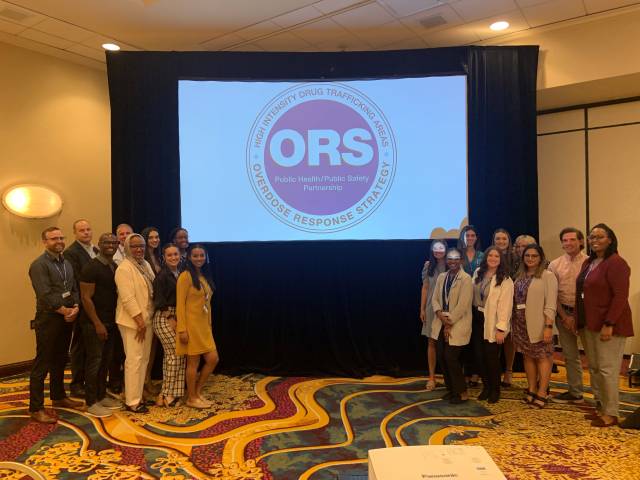You are here
A United Effort: Building National Public Health Capacity for the Overdose Response Strategy
As drug overdose fatalities reach a historic high in the United States, the epidemic continues to devastate the lives of many Americans and their families. Such a complex crisis calls for an innovative approach to bring traditionally siloed sectors together to address the overdose epidemic.
The Overdose Response Strategy (ORS) was created to help local communities reduce drug overdoses and save lives. ORS is funded by the Centers for Disease Control and Prevention (CDC) and the White House Office of National Drug Control and Policy (ONDCP). The CDC Foundation and 33 High Intensity Drug Trafficking Areas (HIDTAs) are working together to support this unique and unprecedented collaboration between public health and public safety, which allows agencies to share timely data, pertinent intelligence and innovative strategies to address overdoses.
Through the project, ORS teams made up of drug intelligence officers (DIO) and public health analysts (PHA) work together on drug overdose issues within and across sectors in all 50 states, Puerto Rico and the U.S. Virgin Islands. Larger states such as California, Florida and Texas have regional jurisdictions with multiple ORS teams.
The CDC Foundation engages with public health and public safety agencies in each jurisdiction, developing and piloting a strategic planning process to allow partners to share needs, identify shared goals and align partners. Through the process, the CDC Foundation actively listens to the needs of each jurisdiction to hire the best suited public health analysts.
To build capacity for the public health arm of the program, the CDC Foundation has fully staffed 60 public health analysts across the nation. Each of these staff will work alongside the drug intelligence officers to ensure public health and public safety overdose-related efforts are collaborative, effective and efficient, sharing drug overdose data, insights and trends to help local communities reduce overdoses and save lives. To ensure that each public health analyst can make an immediate impact in the communities they serve, the CDC Foundation works hand in hand with each jurisdiction throughout every step of the planning and hiring processes.
“I’ve seen amazing things happen when public health and public safety work together,” said Sydney Fox, a CDC Foundation public health analyst in Arizona. “I believe in the cause. I think this is hypercritical work and it’s super exciting to be part of it.”
Tribal communities across the country have been hit especially hard by the opioid crisis, and many of them may have difficulty accessing essential services and resources to combat the epidemic effectively. During a recent cluster of overdose deaths on tribal reservations in Minnesota, one tribe experienced a shortage of naloxone. The Minnesota ORS team learned of this issue in a discussion with their public health and public safety partners, and afterwards met with a naloxone coordinator to develop a plan for equipping tribal law enforcement and first responders with the life-saving drug. Collectively, they emailed all 11 tribal police chiefs informing them of how they could obtain free naloxone and worked to get the word out to all first responders across the state. Following their outreach, 15 agencies reached out to their regional Emergency Medical Services coordinators to obtain naloxone.
The Overdose Response Strategy is a leading national example of cross-agency, interdisciplinary collaboration to reduce overdose deaths and save lives. The CDC Foundation is honored to be part of this critical mission by providing partnership and capacity building, supporting ongoing program implementation, reporting and evaluation, and providing technical assistance and training to the ORS network.
Portions of the project mentioned in this blog post are supported by the Centers for Disease Control and Prevention of the U.S. Department of Health and Human Services (HHS) as part of a financial assistance award totaling $12,665,000 with 100 percent funded by CDC/HHS. The contents are those of the author(s) and do not necessarily represent the official views of, nor an endorsement by, CDC/HHS or the U.S. Government.

